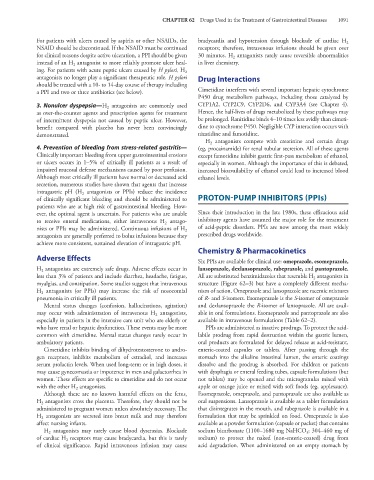Page 1105 - Basic _ Clinical Pharmacology ( PDFDrive )
P. 1105
CHAPTER 62 Drugs Used in the Treatment of Gastrointestinal Diseases 1091
For patients with ulcers caused by aspirin or other NSAIDs, the bradycardia and hypotension through blockade of cardiac H
2
NSAID should be discontinued. If the NSAID must be continued receptors; therefore, intravenous infusions should be given over
for clinical reasons despite active ulceration, a PPI should be given 30 minutes. H antagonists rarely cause reversible abnormalities
2
instead of an H antagonist to more reliably promote ulcer heal- in liver chemistry.
2
ing. For patients with acute peptic ulcers caused by H pylori, H
2
antagonists no longer play a significant therapeutic role. H pylori Drug Interactions
should be treated with a 10- to 14-day course of therapy including
a PPI and two or three antibiotics (see below). Cimetidine interferes with several important hepatic cytochrome
P450 drug metabolism pathways, including those catalyzed by
3. Nonulcer dyspepsia—H antagonists are commonly used CYP1A2, CYP2C9, CYP2D6, and CYP3A4 (see Chapter 4).
2
as over-the-counter agents and prescription agents for treatment Hence, the half-lives of drugs metabolized by these pathways may
of intermittent dyspepsia not caused by peptic ulcer. However, be prolonged. Ranitidine binds 4–10 times less avidly than cimeti-
benefit compared with placebo has never been convincingly dine to cytochrome P450. Negligible CYP interaction occurs with
demonstrated. nizatidine and famotidine.
H antagonists compete with creatinine and certain drugs
2
4. Prevention of bleeding from stress-related gastritis— (eg, procainamide) for renal tubular secretion. All of these agents
Clinically important bleeding from upper gastrointestinal erosions except famotidine inhibit gastric first-pass metabolism of ethanol,
or ulcers occurs in 1–5% of critically ill patients as a result of especially in women. Although the importance of this is debated,
impaired mucosal defense mechanisms caused by poor perfusion. increased bioavailability of ethanol could lead to increased blood
Although most critically ill patients have normal or decreased acid ethanol levels.
secretion, numerous studies have shown that agents that increase
intragastric pH (H antagonists or PPIs) reduce the incidence
2
of clinically significant bleeding and should be administered to PROTON-PUMP INHIBITORS (PPIs)
patients who are at high risk of gastrointestinal bleeding. How-
ever, the optimal agent is uncertain. For patients who are unable Since their introduction in the late 1980s, these efficacious acid
to receive enteral medications, either intravenous H antago- inhibitory agents have assumed the major role for the treatment
2
nists or PPIs may be administered. Continuous infusions of H of acid-peptic disorders. PPIs are now among the most widely
2
antagonists are generally preferred to bolus infusions because they prescribed drugs worldwide.
achieve more consistent, sustained elevation of intragastric pH.
Chemistry & Pharmacokinetics
Adverse Effects Six PPIs are available for clinical use: omeprazole, esomeprazole,
H antagonists are extremely safe drugs. Adverse effects occur in lansoprazole, dexlansoprazole, rabeprazole, and pantoprazole.
2
less than 3% of patients and include diarrhea, headache, fatigue, All are substituted benzimidazoles that resemble H antagonists in
2
myalgias, and constipation. Some studies suggest that intravenous structure (Figure 62–3) but have a completely different mecha-
H antagonists (or PPIs) may increase the risk of nosocomial nism of action. Omeprazole and lansoprazole are racemic mixtures
2
pneumonia in critically ill patients. of R- and S-isomers. Esomeprazole is the S-isomer of omeprazole
Mental status changes (confusion, hallucinations, agitation) and dexlansoprazole the R-isomer of lansoprazole. All are avail-
may occur with administration of intravenous H antagonists, able in oral formulations. Esomeprazole and pantoprazole are also
2
especially in patients in the intensive care unit who are elderly or available in intravenous formulations (Table 62–2).
who have renal or hepatic dysfunction. These events may be more PPIs are administered as inactive prodrugs. To protect the acid-
common with cimetidine. Mental status changes rarely occur in labile prodrug from rapid destruction within the gastric lumen,
ambulatory patients. oral products are formulated for delayed release as acid-resistant,
Cimetidine inhibits binding of dihydrotestosterone to andro- enteric-coated capsules or tablets. After passing through the
gen receptors, inhibits metabolism of estradiol, and increases stomach into the alkaline intestinal lumen, the enteric coatings
serum prolactin levels. When used long-term or in high doses, it dissolve and the prodrug is absorbed. For children or patients
may cause gynecomastia or impotence in men and galactorrhea in with dysphagia or enteral feeding tubes, capsule formulations (but
women. These effects are specific to cimetidine and do not occur not tablets) may be opened and the microgranules mixed with
with the other H antagonists. apple or orange juice or mixed with soft foods (eg, applesauce).
2
Although there are no known harmful effects on the fetus, Esomeprazole, omeprazole, and pantoprazole are also available as
H antagonists cross the placenta. Therefore, they should not be oral suspensions. Lansoprazole is available as a tablet formulation
2
administered to pregnant women unless absolutely necessary. The that disintegrates in the mouth, and rabeprazole is available in a
H antagonists are secreted into breast milk and may therefore formulation that may be sprinkled on food. Omeprazole is also
2
affect nursing infants. available as a powder formulation (capsule or packet) that contains
antagonists may rarely cause blood dyscrasias. Blockade sodium bicarbonate (1100–1680 mg NaHCO ; 304–460 mg of
H 2 3
of cardiac H receptors may cause bradycardia, but this is rarely sodium) to protect the naked (non-enteric-coated) drug from
2
of clinical significance. Rapid intravenous infusion may cause acid degradation. When administered on an empty stomach by

